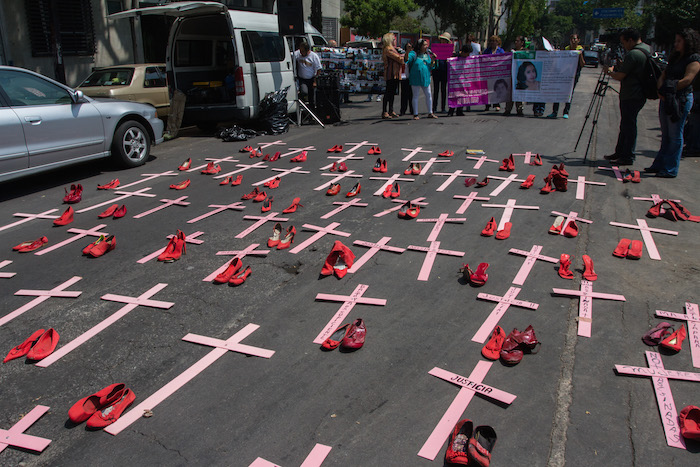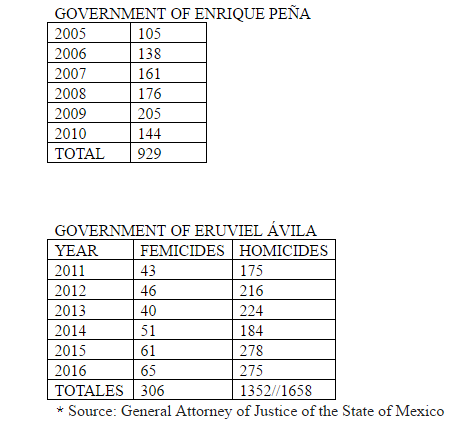
CACHIBACHE CAFE
July 18, 2017
“THE DEAD OF ERUVIEL” IN ECATEPEC, CITY OF CRIME
July 25, 2017FEMICIDES GOT DOUBLED IN SIX YEARS IN THE STATE OF MEXICO

The figure exceeds the historical sexennial of Enrique Peña. Official reports indicate that in Ecatepec, where the governor Eruviel Avila originated, more women have been murdered than in the entire territory, despite being part of the eleven municipalities where the Gender Alert was decreed in 2015.
FEMICIDES GOT DOUBLED IN SIX YEARS IN THE STATE OF MEXICO


The number of femicides in the current administration registers an increase above 12% regarding to the 922 registered cases during the 2005-2011 administration, they already sum at least 1,658 women murdered through this government (till December 31st of 2016), which has provoked that different social organizations and sectors demand the inclusion of more municipalities into the gender alert already implanted in 11 towns, measure taken by some just as “unspoken word”.
According to official numbers of the previous two state’s administrations, in 16 years, a total of 2,761 women have been murdered in the State of Mexico. Due to it, and although in July 2015 the Gender Alert was declared in 11 municipalities with higher rates of violence against women, NGOs consider that there is still a lot of work to do, since so far the measure taken hasn’t given any results, while the municipalities with high incidence of femicides are not included into the alert.
About it, the local deputy Areli Hernandez from the parliamentary group of the National Action Party (PAN in Spanish), sent an exhortation from the local Congress to the Governor to inform about the actions taken in order to eradicate the violence against women, mainly in those 11 municipalities with the declared alert.
The legislator of PAN pointed that “after almost 16 months since the Alert’s Declaratory of Gender Violence in the 11 state towns started, there aren’t any reports of the actions started in the entity, and sadly, violence against women there and homicides with features of femicides, keep showing up.”
“The State of Mexico’s General Attorney of Justice had started 25 investigations for the felony of femicide, which means a 30% raise in the same period of the previous year, besides registering 90 murders of women with violence in the state; while in social networks, until November 21st, there are 232 counted femicides”, she said.
On the other side, the PRD deputy, Yomali Mondragon demanded on her party’s behalf, to be decreed the Gender Alert in the town of La Paz, located at the east of the state, due to the aggressions suffered by the women in the area.
Last July, the first year of the implementation of the gender alert in the 11 municipalities of the State of Mexico was completed, this as result of a long and persevering struggle of various social organizations headed by the National Observatory of Femicide, which has allowed that the magnitude of the Feminicidal Phenomenon in Edomex (State of Mexico), begins to get unveiled.
In this way, the General Attorney of Justice was finally obliged (as part of the measure of the Gender Alert itself) to open its files, which allows to make an exhaustive comparison of the evolution of the problem since the year 2000, when the first reports were known.
The first report indicated that between 2000 and 2005, femicides in the State of Mexico were increasing dangerously. The official figure started with 32 feminicides in 2000; 26 in 2001; 42 in 2002 (at this point, rates seem to duplicate); 28 in 2003; 74 feminicides in 2004; 105 in 2005 and 138 in 2006; that is to say that, curiously when the administration of the governor Enrique Peña Nieto was starting at that moment, feminicides in the entity began to show a sustained growth.
Between 2005 and 2010, this is, during the government of Enrique Peña, there were a total of 929 registered feminicides: 105 in 2005; 138 in 2006; 161 in 2007; 176 in 2008; 205 in 2009 and 144 in 2010.
In this administration and with the criminalization of femicide in 2013, a total of 1,658 women have been killed or murdered, of which 306 cases have been typified as femicides, while 1,352 cases (until December of 2016) have been typified as homicides.
If we sum up the 929 femicides reported during the government of Enrique Peña and the 174 that were registered between 2000 and 2004 - which were deleted from the official statistics during the administration of Alfredo Castillo as prosecutor of justice -, we would have that in 16 years 2,761 women have been killed in the State of Mexico.
2,661 bodies of women who could populate several pantheons and whose cases, in less than 50%, have been solved and still less, not punished.
FEMINICIDAL MUNICIPALITIES
Regarding to the 11 municipalities where the Gender Alert was implemented in 2015, in those areas are concentrated 978 out of the 1,556 reported murders of women (including femicides) at a state level in the current administration.
The above means that until last September (according to the most recent figures released by the State of Mexico's General Attorney of Justice), the 11 towns with a Gender Alert statement, concentrate 62.5% of the cases of femicides as well as intentional homicides of women, at the state level.
Out of the eleven municipalities, Ecatepec is the one that concentrates the largest number of cases of murdered women with 258 homicides and femicides accumulated so far in the current administration; Nezahualcóyotl follows with 140 cases; Chimalhuacán with 86 cases in total; Naucalpan with 87 cases; Chalco with 71 in both cases; 70 in Cuautitlán Izcalli; Ixtapaluca with 58 cases; 91 cases in Tlalnepantla; 61 cases in Toluca (out of which 24 of them are femicides); 53 in Tultitlán and Valle de Chalco has 58 cases.
VICTIMS AND VICTIMARIES
Her body was found upside down near a drainage channel of Chalco Valley; her arms were tied to her back, half-naked and gagged with tape; apparently was dragged to some bushes, where she was raped and suffocated to death, then abandoned in an uninhabited area but very close to her humble home.
She was only eight years old. She went out to buy some lemons for her grandmother at four in the afternoon, but she never went back with the order. In spite of this, no one noticed her absence until half past ten at night. She was a marginalized girl, of slow learning and lonely.
The murder of Luz was part of the long list with 774 women who were murdered between 2000 and 2008 in the State of Mexico and whose cases, more than 70%, were never solved...
Today, thanks to the first study carried out by the Autonomous University of the State of Mexico (UAEM), it is known that feminicidal violence in the entity has many faces, since the newborn baby being thrown into the drainage channels, to the teenager who is kidnapped in Ecatepec, Tecámac or Naucalpan; or single mothers or simply family mothers, beaten to death by their partners, the most common indeed.
That study allowed to start reconstructing the phenomenon, to know for example, that 28% of femicide victims, until the last administration, were between 21 and 30 years old, followed by the group of women between 31 and 40 years old, with 18% of the homicides recorded in that administrative period and another 18% is the group of victims aged from 11 to 20 years old.
This means that from the age of eleven to the age of 40, women in the State of Mexico have a risk in some degree, higher or lower, of being killed.
Regarding the profiles of the victims, we know that 29% were married, 8% were merchants, 10% were employees, 11% were students and 8% were underage girls. Eloisa agonized feeling high levels of pain, the experts agreed. From her bare, bruised body it could not be distinguished her head that was crushed under a huge rock, while from between her legs protruded a hose, still bloodied, with which she was raped still unconscious.
The market of San Lorenzo, in Chimalhuacán, where she was found more than a lustrum, closed that day, 13 of February, due to the bloody scene. She was only 41 years old and she left two daughters in the orphanhood, since she was a single mother.
Her case is one of the few that were solved in a matter of hours, his lover, a 29 years old man, pretended to discover the murder. He took the police, provided data of the victim but in the end he incurred in contradictions and confessed to be the author of the crime. Jealousy was the reason.
At the moment, the Autonomous University of the State of Mexico (UAEM), is making a new research, with specialists in different areas, on the feminicidal phenomenon in the State of Mexico.
The Rector, Jorge Olvera, has emphasized that with this study, it is hoped to find answers around this problem, which allow to generate more efficient public policies of prevention.
In the research work participates an interdisciplinary team to which have been added diverse specialists in criminal law, criminalistics, anthropology and in legal matter as well, among others. The results are expected to be gotten in 2017.
MURDERS OF WOMEN IN THE STATE OF MEXICO






